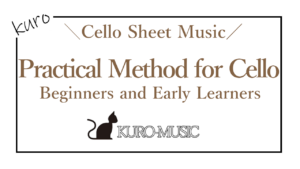Hello, I’m Kuro!
Today, I’d like to talk about how to progress through practice pieces!
Progression varies from person to person, and during lessons, I usually adjust pieces to suit each individual. However, the general structure remains the same, so I’ll share the overarching approach with you!
For Beginners
Practical Method for Cello
My Beginner-Friendly Cello Method Book.
This is a comprehensive method book designed for beginner cellists! It covers all the basics in one book, making it incredibly convenient.
It includes practice pieces, scales, various bowing techniques, recital pieces, position shifts, and more!
Famous pieces like Pomp and Circumstance and Salut d’Amour are also included to make learning enjoyable.
With performance videos included, this book allows you to study the fundamentals while observing proper technique.
It’s a highly recommended method book praised for its ease of learning!
Cello Technique
This book is written at a very beginner-friendly level.
It adopts a small-step approach, with Vol. 1 focusing entirely on the 1st position throughout.
Vol. 2 emphasizes foundational exercises for position shifts.
The first half consists of etudes, each short and easy to play (4–16 measures).
The second half features well-known pieces such as Ave Maria, Air on the G String, and Salut d’Amour, as well as excerpts from S. Lee’s Very Easy Duets Op. 126 and scales.
This book is perfect for those who want to learn at a slow and comfortable pace.
Sapozhnikov or Werner Method Books
Next are the method books by Sapozhnikov and Werner!
Both provide a solid foundation for playing the cello.
However, there are some differences:
・Sapozhnikov: Lacks bowing exercises.
・Werner: Has fewer double-stop exercises.
You might choose based on your personal preferences or after listening to pieces from both books!
Suzuki Method Volume 1
The Suzuki Method Volume 1 is great for those who want to play fun pieces right away!
However, to build a solid foundation, you’ll eventually need to progress through Volumes 1–5 and supplement with other studies (e.g., Sevcik or Loeb).
Sevcik, Loeb, and Cossmann
These practice pieces reinforce the fundamentals and fill gaps left by other methods like Sapozhnikov, Werner, or Suzuki.

Sevcik:
・Op. 2, 3: Right-hand exercises.
・Op. 8: Left-hand exercises, particularly essential for position-shifting practice.
Independent learners may find Sevcik invaluable for structured practice.

Loeb:
Focuses on scales: 4-octave scales, arpeggios, thirds, sixths, octaves, etc.
This is a must-have for scale practice and will remain useful even at advanced levels.

Cossmann:
Combines left-hand and scale exercises.
The first three pages are excellent for warm-ups.
Ideal for isolating left-hand movements for better finger independence.
For Intermediate Players
Schroeder Books 1 and 2

A staple for cellists, these books contain well-known etudes by composers like Lee and Dotzauer.
Schroeder includes exercises for double stops, high positions, fast playing, and more.
Once you’ve mastered Book 2, you’ll likely feel more confident performing in orchestras or chamber groups.
If Schroeder feels too challenging, consider Dotzauer Book 1. It offers simpler pieces for those who need more foundational practice.
For Those Not Ready for Advanced Etudes (Duport or Popper)
Try Lee’s 40 Melodious Etudes Op. 31.
・Fun to play and ideal for bridging the gap between intermediate and advanced levels.
・For readability, I recommend the Schott edition.
For Advanced Players
Duport 21 Etudes

Features extensive double stops, high positions, and technical exercises for both hands.
Pieces are longer (2–6 pages) and musically expressive, sometimes used in recitals.
Begin with the second etude, as the first and twenty-first are particularly challenging.
Popper 40 Etudes

The ultimate in virtuosity! These focus on position shifts and fast playing.
While also featuring double stops and advanced techniques, the pieces are shorter (1–2 pages, occasionally 3–4).
Start with No. 11, a common entry point for this collection.
Bonus for Extreme Enthusiasts
Grützmacher 24 Etudes Vol.2

The later pieces are notoriously difficult, even for advanced players.
Though useful for mastering violin repertoire, these etudes are not essential unless pursuing professional-level skills.
In Conclusion
I hope this guide was helpful!
Generally, you can progress from beginner to intermediate to advanced levels, but sometimes detours with other etudes can make the journey smoother.
Since everyone progresses at their own pace, independent learners may struggle with gaps in their knowledge. Please use this as a reference to navigate your practice!










